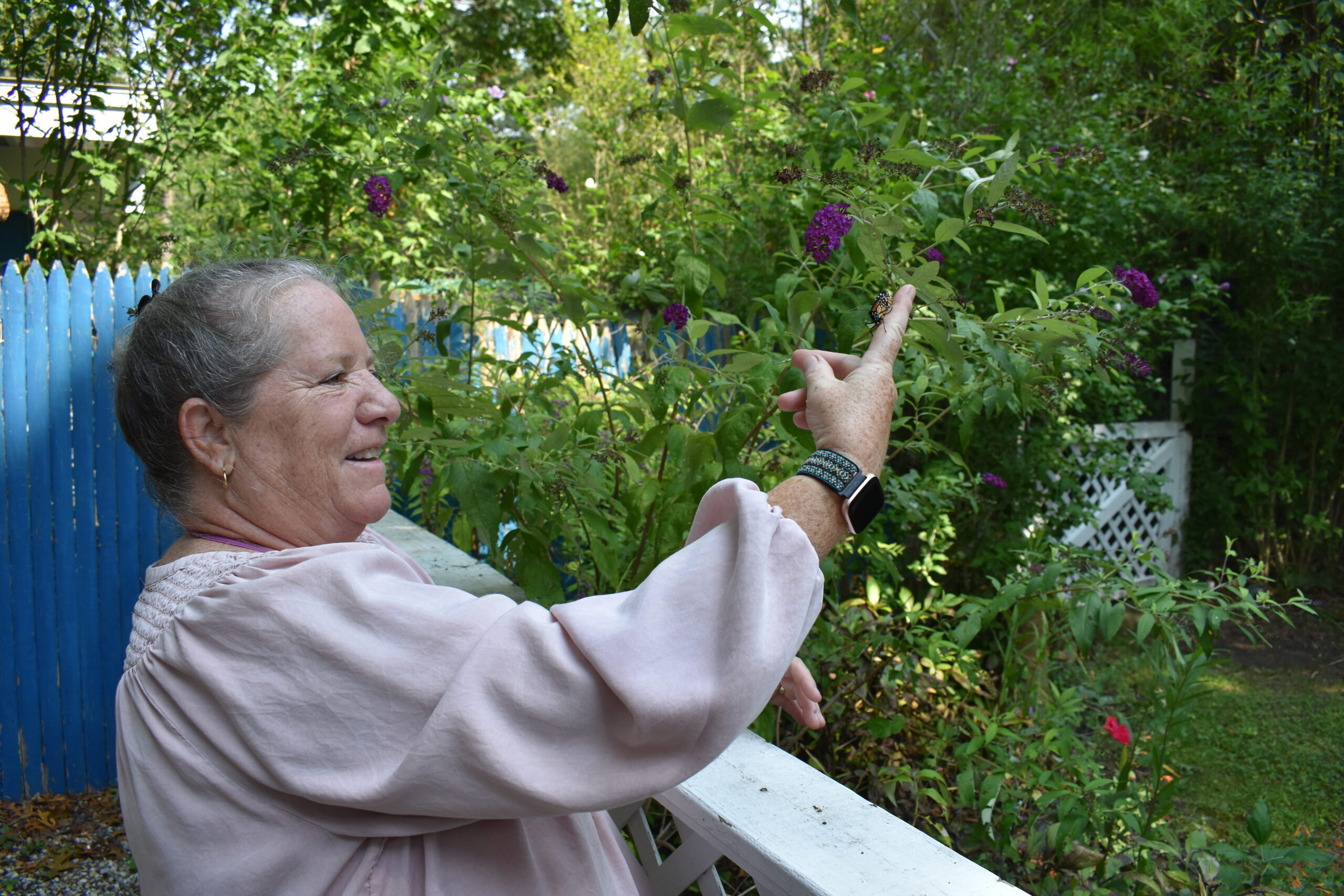
Mary Vienneau, a professional gardener based in East Quogue, took the mantra, “Think globally, act locally,” to heart when she first adopted a monarch caterpillar six summers ago.
“My husband was walking up the pathway to our deck when he saw this very fat, very colorful caterpillar, and recognized it was a monarch. I knew they were endangered, and I was worried that a bird would eat this one, so I took him and the leaf he was eating and made a haphazard hutch for him out of a granola bar box. I fed him milkweed until he went into chrysalis. A butterfly was formed, and I was hooked. That winter I did a lot of research and joined a lot of Facebook groups to learn about how to raise monarchs in a healthy way.”
Since that first caterpillar captured her heart, Vienneau has made it an annual ritual to protect the monarchs that find their way to her and give them a safe start on life. At first she collected caterpillars and eggs, but now she only collects the eggs to prevent parasites that may be living on or in the caterpillars from spreading to her other charges. “There are so many things that can impact them in the wild,” she said. “I decided it’s safer just to collect the eggs. It’s heartbreaking to collect the caterpillars, care for them and then see maggots crawling out of them.”
One ailment that affects monarch populations worldwide is Ophryocystis elektroscirrha, or OE for short. A single-celled organism, OE lives within its host butterfly and releases spores that scatter on the monarch’s eggs and the milkweed leaves she lays them on. When the eggs hatch, the caterpillars ingest the spores along with the milkweed, and as the caterpillars develop through the chrysalis phase, the parasites multiply and cause a range of maladies, from deformed wings and decreased flight endurance to impaired mating ability in males. There’s no cure for OE, but Vienneau learned that she could test her newly emerged butterflies for it.
“A few years ago, I had a lot of caterpillars that were coming out deformed. I started testing for OE, which you can do by pressing a piece of clear tape to their little bellies. If they have a lot of spores it looks like micro-glitter. I had to euthanize so many that year. It’s a hard lesson. It broke my heart, but I feel like that year really toughened me up. I know that I’m helping the rest of the butterflies by not releasing the sick ones. You really don’t want them spreading more OE.”
This year, Vienneau raised 120 monarchs, the last of which she’ll be releasing when they emerge from their chrysalises later this month. From her garden, they’ll begin the trek south, migrating 3,000 miles to Mexico. “The monarch is so iconic. This is a butterfly that will fly 3,000 miles, from Long Island to Mexico. It will roost there for the winter, then start the flight back. On the way back, some of them will stop and lay eggs along the way.”
Monarchs die soon after breeding, so the ones that stop and lay eggs don’t make it all the way back to Long Island — they finish out their lives along the way. Some end up even farther north, all the way up to Maine. While the monarchs that hatch earlier in the season live for about a month, the last generation to hatch before migration — called the Methuselah generation, after the 969-year-old biblical patriarch — will live for around eight months, long enough to survive the round-trip to Mexico. They also have bigger wings than earlier generations, making it a little easier for them to undertake the journey south.
The key to monarch survival is the milkweed plant. While the butterflies will feed on pollen from almost any flower, the caterpillars can only feed on milkweed leaves. A common plant that grows in many varieties around the world, milkweed is also targeted by pesticides used in agriculture. Where milkweed used to grow in plenty alongside farm fields, the use of Roundup sprayed over those fields has wiped much of it out.
Easy to grow and available in a variety of sizes and colors, milkweed is a good addition to a home garden, and serves as a welcome mat for passing monarchs looking for a place to lay their eggs.
Vienneau says watching the caterpillars develop into butterflies never gets old. “I get to watch them pupate, I get to watch them come out of their chrysalises. A little insect that was a caterpillar turns itself into liquid, then in seven to 10 days turns itself into a butterfly. It’s fascinating!”
If you’re interested in learning more about cultivating your own brood of monarchs, Vienneau offers occasional educational seminars. You can reach her at mvgarden@optonline.net.